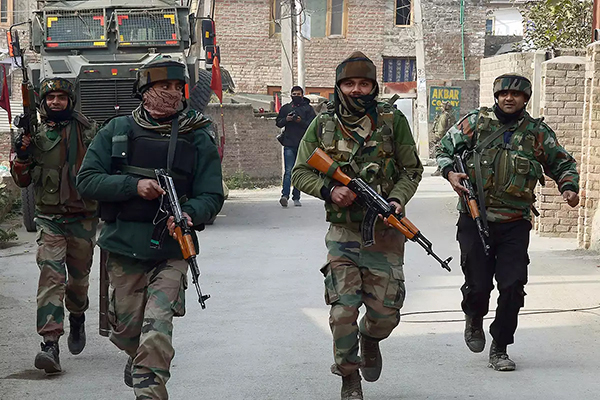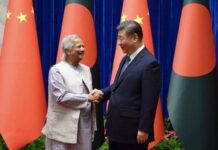
Three-and-a-half years after the Union government revoked the special status granted to Jammu and Kashmir amid deployment of large additional troops, it is discussing a proposal to withdraw the Indian Army completely from the Valley hinterland. If approved, the Army will have presence only on the Line of Control (LoC).
Officials in the security establishment said the proposal to withdraw the Army from Kashmir hinterland has been under discussion for about two years and is at an “advanced stage” now with the involvement of the Union Ministry of Defence, Union Ministry of Home Affairs, armed forces and the J&K police. It is proposed that the CRPF would fill in for the army personnel removed from the Valley to meet the challenges of both law and order and counter-terror operations.
“The matter is under serious discussion at inter-ministerial level and it is understood to be feasible. In a way, the decision has been taken and it is a matter of when it will be done. Ultimately, however, it will be a political call,” a senior security establishment officer said.
Texts and calls to the CRPF, J&K Police and the Army did not elicit a response till the time of going to press.
According to officials, the Army maintains a strength of around 1.3 lakh personnel in the entire J&K of which around 80,000 are deployed on the border. About 40,000-45,000 personnel from the Rashtriya Rifles have the mantle of conducting counter-terror operations in Kashmir’s hinterland.
The CRPF is said to have a strength of close to 60,000 personnel in J&K, of which more than 45,000 are deployed in Kashmir Valley. J&K Police is 83,000 strong. Apart from this, a few companies from other Central Armed Police Forces (CAPF) remain deployed in the Valley. The figures for CAPFs fluctuate depending on the security situation in the Valley.
The idea behind the deliberations is to not just claim normalcy in Kashmir but also make it visible. The government claims that terrorist violence incidents and killing of security personnel in J&K have reduced by almost 50 per cent since August 5, 2019, compared with the same period before it. “Since the August 5, 2019 decisions, violence in the Valley has steadily reduced. Stone pelting has almost vanished and the law-and-order situation is largely under control. However, a large presence of the Indian Army in the hinterland would sit oddly with claims of normalcy,” a Union home ministry official said.
Political call
Political parties in J&K as well as some wings of the government have been pushing for a complete withdrawal of the Army. This has gathered momentum in recent months with many in the government impressing upon the political leadership that the claims of normalcy may be followed with action such as the phased removal of Army from the Valley’s districts.
According to another government official, the ideal situation, as discussed during the deliberations, would be to hand over the mantle of counter-terror operations in the hinterland to Jammu and Kashmir Police.
“However, at the moment the Union Territory police force is not being viewed as fully prepared and having the wherewithal to replace the Army on its own. So, the idea is to have J&K Police along with the Central Reserve Police Force (CRPF) fill in for the Army when it is withdrawn. They have also demonstrated over the years their capability in Srinagar where the Army is not present. The details of it, in terms of how many more CRPF personnel would be required for this and how the entire command structure will function, is being worked out,” the official said.
Sources in the security establishment said that in the discussions it was proposed that the Army be withdrawn in a phased manner. “May be the Army can be withdrawn first from a couple of districts such as Anantnag and Kulgam. Following this, the situation on the counter-terror front and the response of the people would be assessed. Depending upon the results, further steps towards more withdrawals would be taken. That’s how it was done when the Border Security Force (BSF) was withdrawn from hinterland Kashmir in the mid-2000s,” another official said.
The official said that one proposal discussed is to remove the Rashtriya Rifles (RR) of the Indian Army in three phases and replace them with CRPF. The RR, set up in 1990, with a mandate to conduct counter-terror operations in the Valley hinterland, never had a permanent mandate, the official said.
Another official, privy to details of the discussions, said as of now the Army is only talking about decreasing the strength and not removing RR completely. The Army, according to defence sources, is already planning a resizing.
“They (RR) are affiliated to various infantry units. By continuing to deploy them for such long periods in internal security duties, you are bleeding the Army units. Army is meant for major tactics and battles. RR has been excellent in the Valley. But time has come to send it back to its core duties,” the official said.
The Army, defence sources said, is already working on resizing the Rashtriya Rifles. The plan is to reduce the 63 battalions of RR by two companies each (each RR has six companies now). It is being discussed if one force headquarters (five in all) and a few sector headquarters (total of 15) of RR can also be reduced, even as the drawdown plan is yet to be finalised. This could add up to over 15,000 troops.
Counter-terror operations in the Kashmir Valley are carried out by the Indian Army with the support of CRPF and Jammu and Kashmir Police. Since the onset of militancy in the Valley, the Army has had a primary role in not just stopping infiltration at the border but also thwarting terror attacks and eliminating militants inside Kashmir through the creation of Rashtriya Rifles in 1990. It did this with J&K Police and the BSF till 2004-05 and has been supported by the CRPF and local police since. Also, in Srinagar, all counter-terror operations since 2005 have been carried out by CRPF and J&K Police, with the RR being kept out.

















